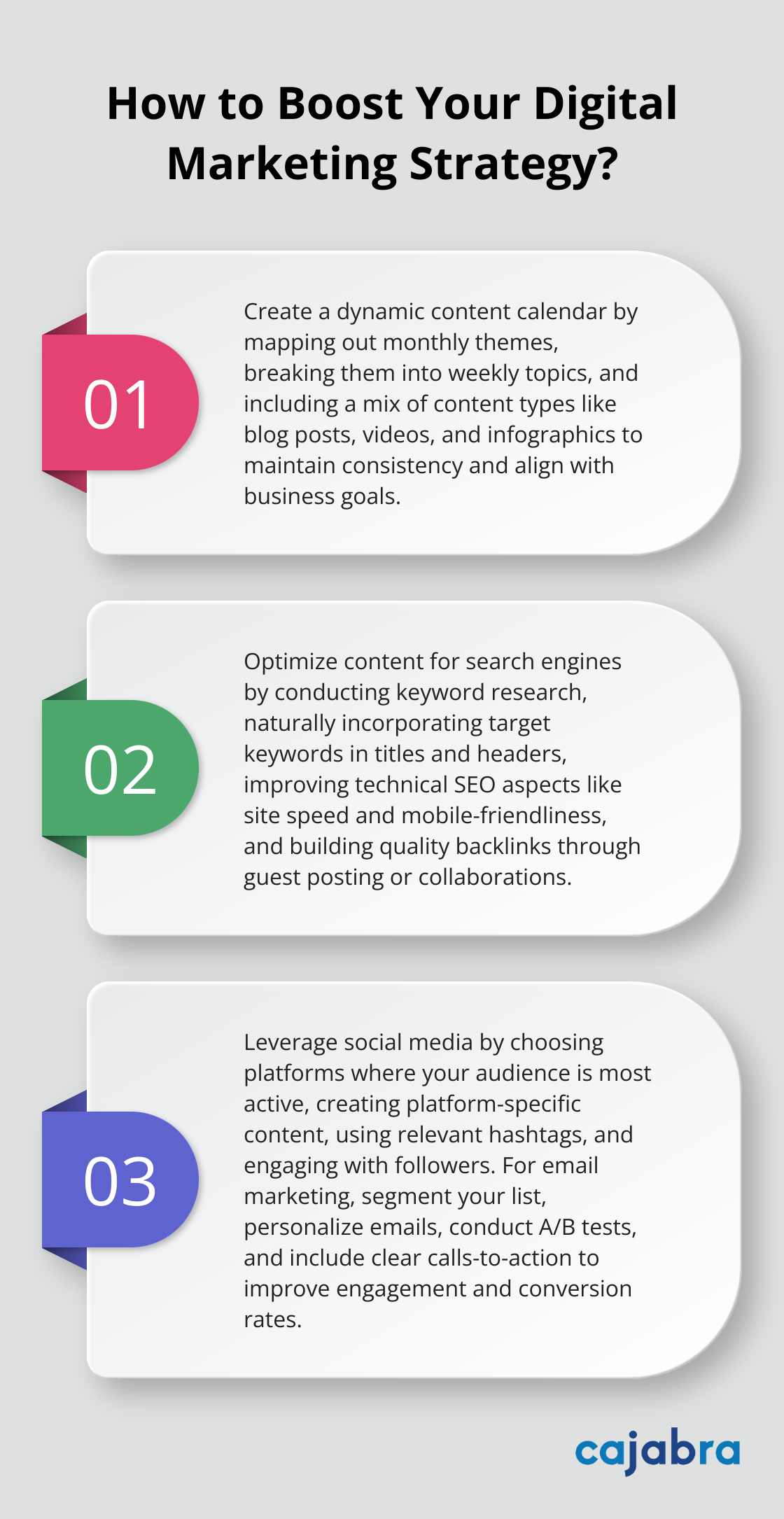
Content marketing is a powerful tool for businesses to attract and engage their target audience. At Cajabra, LLC, we've seen firsthand how effective strategies can drive growth and boost brand awareness.
In this post, we'll share our insights on creating content marketing strategies that deliver results. We'll cover everything from defining your audience to choosing the right content types and distribution channels.
The foundation of every successful content marketing strategy rests on a thorough understanding of your target audience. This knowledge prevents your efforts from missing the mark and failing to connect with your intended recipients.
Market research forms the cornerstone of audience discovery. This process extends beyond mere demographics; it uncovers the pain points, desires, and behaviors of your potential customers. Tools like Google Analytics offer valuable insights into your website traffic, revealing who engages with your content. Social media analytics provide additional information about your followers' interests and online behaviors.

A study by the Content Marketing Institute reveals that top-performing B2B content marketers customize their content to specific stages of the customer journey. This underscores the importance of understanding not only who your audience is but also their position in the decision-making process.
Once you have a clear picture of your audience, it's time to establish objectives. These should adhere to the SMART criteria (Specific, Measurable, Achievable, Relevant, and Time-bound). For example, instead of a vague goal like "increase website traffic," try for something more specific: "increase organic traffic to our blog by 25% within the next six months."
HubSpot reports that marketers who set goals are 376% more likely to report success than those who don't. This statistic highlights the critical role clear objectives play in driving content marketing success.
Buyer personas represent semi-fictional depictions of your ideal customers based on real data and market research. These personas transcend basic demographics to include psychographic information such as values, fears, and aspirations.
A study by ITSMA found that 90% of companies using personas have created a clearer understanding of their buyers. This clarity directly translates into more effective content creation and targeting.
When crafting your personas, include details such as:
The goal isn't to create fictional characters, but to represent real segments of your audience. Use surveys, interviews, and data analysis to inform these personas.
Your content marketing strategy should directly support your overall business objectives. This alignment ensures that your content efforts contribute to tangible business outcomes (such as increased revenue or market share).
Consider how your content can:
With a solid understanding of your audience and clear goals in place, you're ready to move on to the next crucial step: choosing the right content types and channels to reach and engage your target market effectively.
The selection of content formats significantly impacts the success of your marketing strategy. Google Analytics provides valuable insights into content performance. The Content Marketing Institute reports that 73% of B2B marketers use website analytics to measure content effectiveness.

Different audiences prefer various formats. A Demand Gen Report revealed that 48% of B2B buyers consume 3-5 content pieces before engaging with sales. White papers, e-books, and case studies ranked as top choices for early and middle stages of the buying process.
Visual learners often respond better to infographics and videos. HubSpot's research shows that 54% of consumers desire more video content from brands they support. For audiences who prefer quick information, short-form videos or social media posts prove effective.
Your distribution channels should match your target audience's online habits. Social media platforms, email marketing, and company blogs serve as common starting points (but don't overlook industry-specific forums or platforms).
LinkedIn stands out for B2B content distribution, with 94% of B2B marketers using it for content marketing. B2C businesses might find platforms like Instagram or TikTok more suitable, depending on their target demographic.
Email marketing remains a powerful tool for content distribution. Campaign Monitor found that email marketing generates an ROI of $44 for every $1 spent, making it essential for lead nurturing and customer relationship maintenance.
A diverse content mix allows you to cater to different audience segments and various stages of the buyer's journey. Maintain consistency in your brand voice and message across all formats and channels.
Content clusters around core topics relevant to your audience improve SEO and provide comprehensive resources. HubSpot's research indicates that companies creating more content clusters see increased organic traffic over time.
Experimentation with new formats or channels is essential. The digital landscape evolves constantly, and today's effective strategies might not work tomorrow. Regular review of content performance metrics enables strategy adjustments based on data.
As we move forward, we'll explore how to develop a robust content creation and distribution plan that maximizes the impact of your chosen formats and channels.
A content calendar forms the backbone of your content strategy. It helps you maintain consistency, plan ahead, and align your content with important dates or events. According to Sproutworth, 40% of B2B marketers have a documented content marketing strategy.

Start by mapping out your content themes for each month. Consider seasonal trends, industry events, and your business goals. Then, break these themes down into specific topics and assign them to different weeks.
Next, decide on the frequency of your content publication. HubSpot's research shows that companies publishing 16+ blog posts per month receive 3.5 times more traffic than those publishing 0-4 monthly posts. However, quality should always take precedence over quantity.
Include a mix of content types in your calendar. This could include blog posts, videos, infographics, and podcasts. Diversifying your content caters to different audience preferences and keeps your strategy fresh.
Search engine optimization (SEO) increases your content's visibility. A study by BrightEdge found that 53% of all website traffic comes from organic search. To maximize your SEO efforts:
Social media and email marketing serve as powerful tools for content distribution. Sprout Social reports that 80% of marketers say social media marketing has increased traffic to their websites.
For social media:
For email marketing:
Content marketing strategies require careful planning, execution, and refinement. We define target audiences, set clear goals, and develop buyer personas to lay a solid foundation. Choosing appropriate content types and distribution channels ensures our message reaches the right people at the right time. A well-structured content calendar, SEO best practices, and strategic use of social media and email marketing amplify our content's impact and reach.

The digital landscape evolves rapidly, as do audience preferences and behaviors. We analyze content performance, gather feedback, and stay informed about industry trends to adapt our strategy and improve our content marketing efforts. Consistency and quality are key (it's better to produce fewer high-quality pieces than to flood channels with mediocre material).
We offer content marketing strategy services to help accounting firms stand out and attract high-value clients. Our approach combines cutting-edge strategies with industry-specific insights to deliver measurable results. Start by reviewing your current content marketing efforts, identifying areas for improvement, and implementing the tactics we've discussed.



